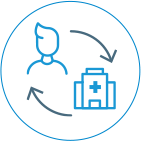
Get the full story of the microbiome
- Importance of Microbial Diversity
- Dysbiosis and Recurrent C. difficile Infection
- Historic Microbiome Restoration Approaches
- Patient and Healthcare Burdens
C. difficile infection (CDI) is one of the most common
healthcare-associated infections in US hospitals, affecting
approximately half a million people annually.1,2

Patient Burden

Recurrence is a vicious cycle
- Up to 35% of patients experience recurrence1,3,a
- Up to 65% of patients experience subsequent recurrences4,5

Physical and psychological suffering continues
From a 2017 study that surveyed patients with CDI or recurrent CDI (rCDI), a majority of 350 patients who have experienced CDI or rCDI report physical and psychological symptoms6
- 41% of patients believed they would never get rid of post-CDI symptoms6

CDI can lead to significant complications including sepsis, colectomy, and mortality
Sepsis
- 27% of patients (aged 18 to 64 years) with one recurrence experienced
sepsis during 12-month follow-up7,b
Colectomy
- 7% of patients with one recurrence had a colectomy during 12-month
follow-up7,b
Mortality
- 6% of patients with index CDI within 30 days of diagnosis1
- 25% of Medicare patients with rCDI at 12 months8
- 52.5% of Medicare patients with rCDI who developed sepsis at 12
months7,b
Other severe complications in patients include heart failure (43%),9,c anxiety (14%),10,d and depression (15%).10,d
aWithin 8 weeks after initial CDI diagnosis.
bLongitudinal, retrospective study of the US PharMetrics Plus™ database reported on complications of CDI recurrence over 1 year (N=46,571) from a single referral center.
cRetrospective study of a Medicare claims analysis of patients with CDI (N=268,762).
d12-month follow-up of retrospective cohort study at first recurrence (N=38,163).

Healthcare Burden

Hospitalizations
- Up to 84% of all patients with rCDI were hospitalized within a year in a single center study11
- Up to 85% of all patients with rCDI were readmitted within a year in a single center study12

Length of stay
- Hospitalizations averaged 18 days for patients with rCDI in a single center study of Medicare patients >65 years of age9

Costs
- $131K to $207K in total direct costs per patient with rCDI within a year in a study of state institutional databases13
- A -$3K to -$29K gap existed in reimbursement per patient with rCDI in a study of state institutional databases14
According to the CDC, CDI is classified as an immediate public health threat requiring aggressive, urgent action15
